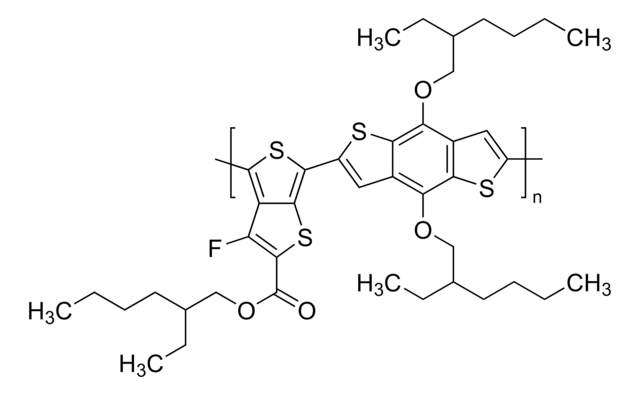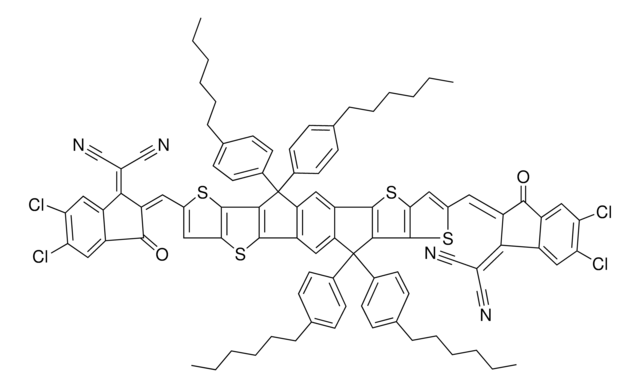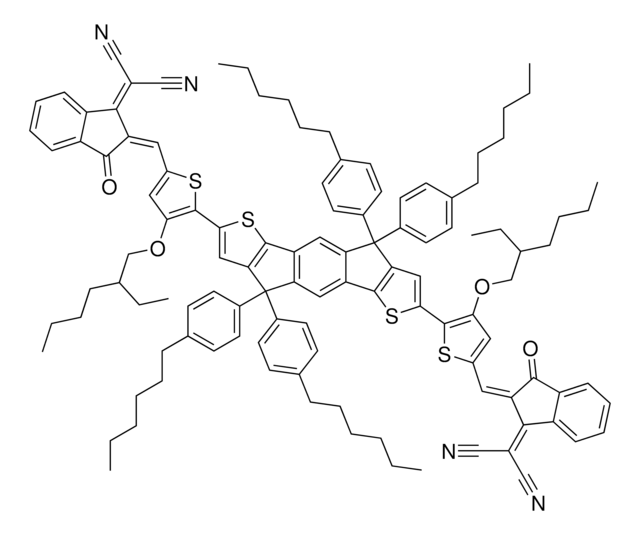910635
IDT-2Br
≥99%
Sinonimo/i:
5,5′-[[4,4,9,9-Tetrakis(4-hexylphenyl)-4,9-dihydro-s-indaceno[1,2-b:5,6-b′]dithiophene-2,7-diyl]bis(2,1,3-benzothiadiazole-7,4-diylmethylidyne)]bis[3-ethyl-2-thioxo-4-thiazolidinone], IDT-BT-R
About This Item
Prodotti consigliati
Descrizione
Band gap: 1.83 eV
Saggio
≥99%
Forma fisica
solid
PM
1518.20 g/mol
Colore
dark
Solubilità
chloroform: soluble
Energia dell’orbitale
HOMO -5.52 eV
LUMO -3.69 eV
Descrizione generale
Applicazioni
Ternary blend organic solar cells (OSCs) with photoresponses beyond 1000 nm can be fabricated using PTB7-Th as donor and ultralow-bandgap F8IC and medium-high bandgap IDT-2BR as NFAs. A PCE of 12.1% has been achieved by such a ternary device with 20% IDT-2BR content in acceptors. In this work, IDT-2BR was found to contribute simultanously to the improvement of the open-circuit voltage (VOC), short-circuit (JSC) and fill factor (FF) of the PTB7-Th/F8IC blend, due to smaller energy offset for charge separation, suppressed charge recombination, and imporved light absorption. Improved packing due to the coexsitence of F8IC and IDT-2BR leads to higher mobilities and more balanced charge transport, which contribute to the improved FF as well.
Additionaly, blends with IDT-2BR have been found to be thermally stable at 150 Celsius.
A ternary blend using both IDT-2BR and fullerene based acceptor: PC71BM (Product No. 684465) has also reached a PCE over 12%.
Codice della classe di stoccaggio
13 - Non Combustible Solids
Classe di pericolosità dell'acqua (WGK)
WGK 3
Punto d’infiammabilità (°F)
Not applicable
Punto d’infiammabilità (°C)
Not applicable
Certificati d'analisi (COA)
Cerca il Certificati d'analisi (COA) digitando il numero di lotto/batch corrispondente. I numeri di lotto o di batch sono stampati sull'etichetta dei prodotti dopo la parola ‘Lotto’ o ‘Batch’.
Possiedi già questo prodotto?
I documenti relativi ai prodotti acquistati recentemente sono disponibili nell’Archivio dei documenti.
Articoli
Professor Chen (Nankai University, China) and his team explain the strategies behind their recent record-breaking organic solar cells, reaching a power conversion efficiency of 17.3%.
Il team dei nostri ricercatori vanta grande esperienza in tutte le aree della ricerca quali Life Science, scienza dei materiali, sintesi chimica, cromatografia, discipline analitiche, ecc..
Contatta l'Assistenza Tecnica.


![Poly[(9,9-dioctylfluorenyl-2,7-diyl)-co-bithiophene] 99.9%](/deepweb/assets/sigmaaldrich/product/structures/309/000/8b4a3f54-7765-4aca-96c4-74ce328d455d/640/8b4a3f54-7765-4aca-96c4-74ce328d455d.png)




